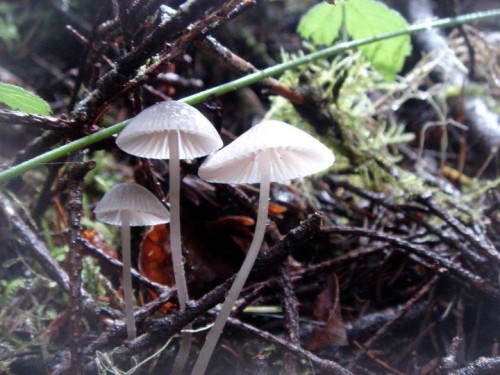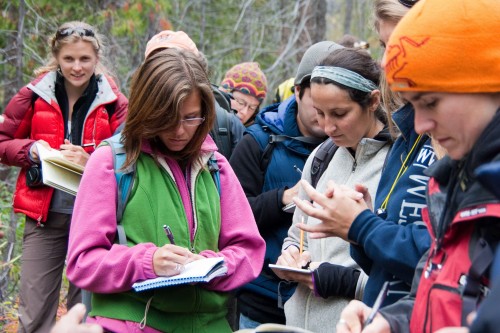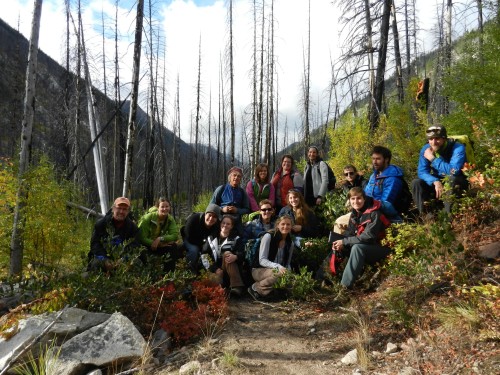From Teacher to Student and Back Again
 Last weekend Cohort 11 graduate students had the chance to step away from our roles as Mountain School Instructors and again return to being students of Natural History during our three day Fall Grad Retreat. After weeks of training and teaching 5th and 6th grade youth about the diverse ecosystems of the North Cascades, the respite from such high activity was much appreciated by all. Our explorations took us by hand and knee through douglas fir forests near home, and by car and foot through the ponderosa pine and fire-scarred forests in the Methow Valley.
Last weekend Cohort 11 graduate students had the chance to step away from our roles as Mountain School Instructors and again return to being students of Natural History during our three day Fall Grad Retreat. After weeks of training and teaching 5th and 6th grade youth about the diverse ecosystems of the North Cascades, the respite from such high activity was much appreciated by all. Our explorations took us by hand and knee through douglas fir forests near home, and by car and foot through the ponderosa pine and fire-scarred forests in the Methow Valley.
Day one of the retreat was spent near the North Cascades Environmental Learning Center campus with M.Ed. graduate alumna and mycologist Lee Whitford discussing the amazing yet unfamiliar world of fungi and their fruiting mushroom bodies. After learning some basic facts and characteristics about our earthy friends, we set out to do some local harvesting of our own (on Forest Service land, of course!). It took some time to adjust our eyes and hone our observational skills to the often unnoticed specimens hidden between leaf, detritus, and tree trunk, but half an hour and handfuls of mushrooms later our forage had yielded an impressive and diverse variety of them.
Lee prompted us to share observations about our favorite discoveries with the group, for the day was more about learning to look at what was in front of us than memorizing its name and moving on. Then, after marveling for a while more at our treasures, we headed back to the Environmental Learning Center to identify our specimens. This proved to be no easy task, but with much patience and guidance from Lee, Ranger Carolyn, and each other, we were able to identify many mushrooms to genus. Turns out everything about a mushroom can be a clue to discovering its identity, the trick is to ask the right series of questions: Spore color? Is the cap tall, thin, etched, fibrous, or funnel-shaped? What about the gills? Are they notched, straight, detached, brittle, soft? And don’t forget to look at whether the stem is chalky or bendy. Oh, and maybe the gills leak white when cut or the cap is sticky. You didn’t check that? Well, start again from the top of the key! At the end of the day, it didn’t matter so much whether we came away knowing the names of every mushroom growing in the North Cascades, but rather that we had spent some time learning to be more attentive and detailed observers of the fungi world beneath our feet.

 Above two photos: (Top) Kiira Heymann describing a mushroom she found while foraging, (Bottom) Some of the tools used for keying out our mushrooms. Photos by Tanya Anderson and Jess Newley.
Above two photos: (Top) Kiira Heymann describing a mushroom she found while foraging, (Bottom) Some of the tools used for keying out our mushrooms. Photos by Tanya Anderson and Jess Newley.
Day two took us over the mountains to the Methow Valley. Faces were full of smiles to be greeted with views of snow-dusted peaks colored gold by turning larches, the faint vanilla smell of ponderosa pine bark and, most thankfully, the sun! Dana Visalli, botanist and editor of The Methow Naturalist, joined our group for the day as we explored the recently burned hillsides from the 2006 Tripod Fire. As we hiked, discussion turned to forest succession in fire-adapted ecosystems and the diverse plant community beginning to retake the land. Like Lee, Dana had us sitting trail-side with hand-lenses using dichotomous keys to identify the last of the late summer wildflowers. More practice in training our minds to be thoughtful and observant of our surroundings.

 Above two photos: (Top) View of the Tripod fire and resplendent understory community beginning to regenerate, (Bottom) C11 Grads taking notes while hiking with Dana Visalli. Photos by Jess Newley.
Above two photos: (Top) View of the Tripod fire and resplendent understory community beginning to regenerate, (Bottom) C11 Grads taking notes while hiking with Dana Visalli. Photos by Jess Newley.
We finished the day with an evening of cultural history at the Twisp Pub and were joined by Byron Ricks, a writer, kayaker, and North Cascades Institute Board Member. After satiating our bellies with delicious food and beverages, we headed back to camp to fill the night with stories and laughter around the campfire.
On the third and final day of our retreat, we spent the morning with Byron, our instructor for the day, talking about writing and the art of language. Discussions were broken up with short inspirational readings and soft dulcimer melodies played by our instructor, each time a gentle reminder to return to the work at hand. As we explored the writing process, talk turned to the place where language and land intersect, where ideas begin and where connections between the natural world and ourselves are formed. It seemed to be a provoking and informative workshop for everyone as we continue to explore the world of natural history with a notebook and pen.
 Grads gather at the end of our Day 2 hike with Dana Visalli and Professor John Miles. Photo by Kiira Heymann.
Grads gather at the end of our Day 2 hike with Dana Visalli and Professor John Miles. Photo by Kiira Heymann.
In our final closing circle, appreciation was echoed by all for the range of topics shared with us by Lee, Dana, and Byron, for the opportunity to spend time together as a group, and for the reminder to continually seek ways to immerse ourselves as students in the natural world. Feeling renewed, inspired and eager to share all we had learned, the C11 Grads returned to the Environmental Learning Center to step back into our role as Mountain School Instructors and Naturalists.
Leading Photo: Tiny cap mushrooms found growing under leaf and twig. Photo By Tanya Anderson.

